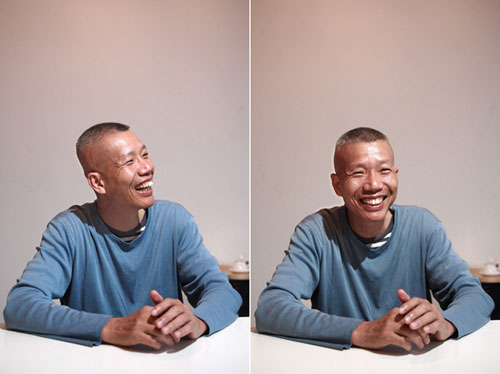 |
|
Chinese artist Cai Guoqiang [Photo: artron.net] |
The 3rd AAC Art of China Awards on Saturday provided a flashback to last year's opening ceremony of the Beijing Olympics by honoring Cai Guoqiang, the mastermind behind the gala's fireworks show, as an "Artist of 2008".
Cai shared the most coveted award of the night with Xu Bing and Liu Xiaodong, as the annual awards gave out eight prizes recognizing last year's most influential art participants in China.
"Cai Guoqiang: I Want to Believe", a retrospective exhibition of the artist's works that had attracted full houses in New York and Beijing, was named "Exhibition of 2008".
Preparing for another exhibition in Spain, Cai had a friend read his thank-you message at the awards ceremony in Beijing.
"I want to thank the jury for giving me the honor ... My involvement in the Olympics was an arduous, lonely experience of learning. 'I Want to Believe' shows an artist's lonely, uncertain life journey ... The occasionally winning of awards offers consolation to an artist; it means at least there are people who like his works."
Another big winner of the night was Xu Bing, whose return to China after an 18-year sojourn in the United States was hailed by the awards as one of the 10 "Art Events of 2008".
Xu, who has been active in the global art scene since early 1990s, is now the vice president of his alma mater, the China Central Academy of Fine Arts in Beijing.
"[Xu Bing's return] means a lot to China's art circle, but [it is a] sacrifice to himself," jury president Gao Minglu said as he presented the "Artist of 2008" award to Xu. "[With his busy schedule at the school,] he has little time for his own art career."
"I came back to China because of my special feeling for my alma mater and Chinese contemporary art," Xu told the audience. "I actually enjoy the current art atmosphere here, which I think will inspire me more than before."
Both Xu Bing and Cai Guoqiang were among the 10 "Art People of 2008" selected by more than 200,000 Internet users and dozens of media outlets.
Social responsibility of artists
Among the keywords in China in the eventful year of 2008 was "earthquake". The AAC awards marked this by highlighting the theme of the "social responsibility of artists".
A special award was given to veteran artist Fan Zeng along with a group of realism painters and Beijing's Poly auction house for their fundraising efforts following the Sichuan earthquake on May 12.
Seventy-year-old Fan, a long-time philanthropist, had led participants of an UNESCO seminar in observing a minute of silence for quake victims days after the earthquake occurred. He also donated 10 million yuan (US$1.5 million) during a fundraiser for quake victims.
Chinese art in the global economic recession
"Economy" was another keyword of 2008. The global financial crisis led to a drop in art auction sales. In both New York and London, which are the world's art trade centers, auction sales in the later half of 2008 dropped by as much as 50 percent compared to sales in the first half of the year.
The art market in China has not been immune. Take artist Zeng Fanzhi's works for example. Last May, Zeng's painting "Mask Series 1996 No.6" fetched US$9,703,490, setting a new world auction record for Chinese contemporary art. Yet according to an analysis of last year's Chinese art market by Artron.net (the organizer of the AAC awards), the profit yielded by Zeng's 19 artworks auctioned in the second half of 2008 was not even half of that made by the same number of works in the first half of the year when the financial climate was relatively better.
Artron's report shows that sales in Chinese auctions last autumn plummeted to almost half of that of the same period the year before, with oil paintings and contemporary art bearing the brunt of the drop.
But according to Gong Jisui, an expert in the Chinese art market and art investing, the global economic recession may eventually have a positive effect on China's art market.
"In the past a few years, we have over-emphasized the concept of art collecting as an investment," Gong said. "Traditionally, art collecting is something for your own aesthetic satisfaction."
Gong said he believes the financial crisis provides a good opportunity to help art collectors get back to the basics. He also believes China's art market is booming with too many bubbles, but with the drop of art prices and people becoming less obsessed with the financial side of art collecting, the global financial crisis will help break these bubbles.
The question now is, how many bubbles will the Chinese art market have to break? Mei Jianping, the co-creator of the Mei Moses Fine Arts Index, may have the answer.
The Mei Moses Index, which uses the historical auction performances of artworks to provide guidance in determining appropriate purchase and sales prices, has been widely accepted in the West. Mei says he is working on a Chinese version of the index. Besides showing people how the art market develops at large, it is expected to help Chinese art investors decide how much money they should invest in the market for higher earnings and lower risk.
(CRI March 2, 2009)